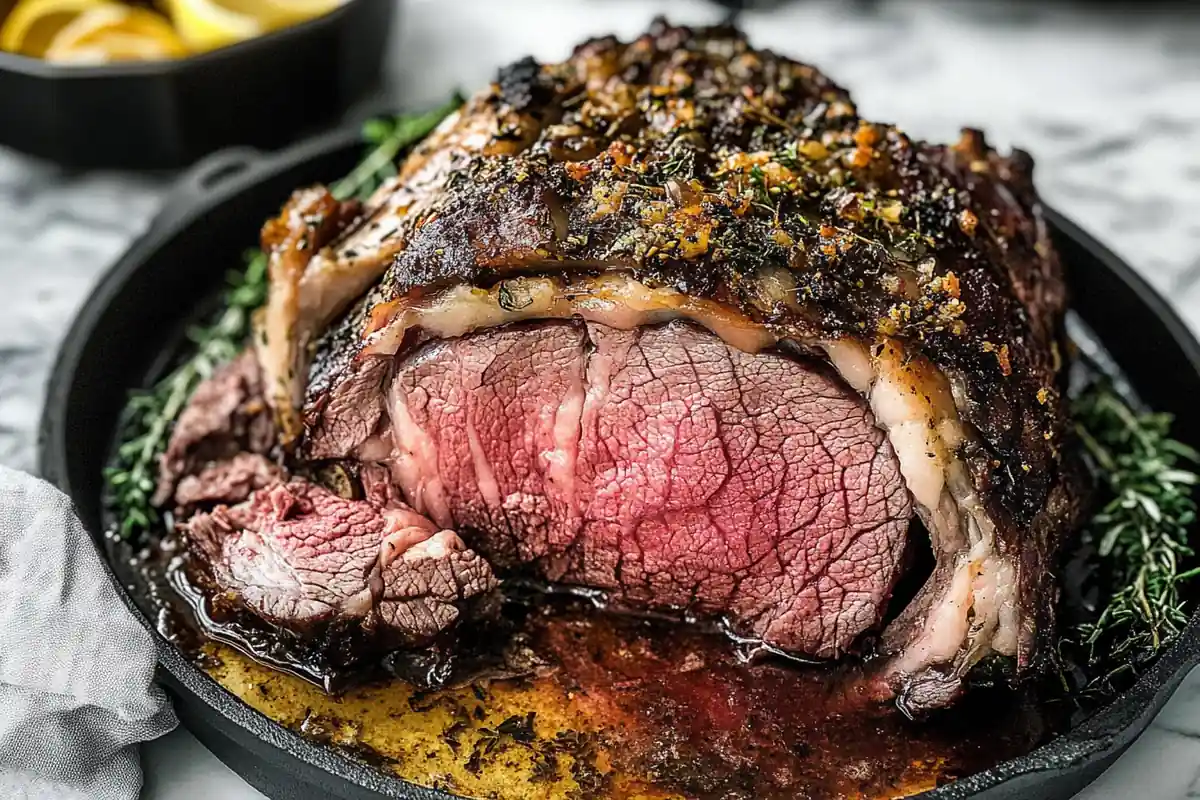Learn to cook a perfect boneless prime rib recipe. This guide offers tips for tender, juicy results every time. Follow our simple steps.
The Ultimate Boneless Prime Rib Recipe: A Step-by-Step Guide
A boneless prime rib recipe can seem intimidating. However, with the right techniques, you can achieve restaurant-quality results at home. This comprehensive guide covers everything from choosing the right cut to carving your masterpiece. We’ll explore various methods to ensure your roast is cooked to perfection. Therefore, even beginners can feel confident tackling this delicious dish.
Choosing Your Boneless Prime Rib
Selecting the right cut of meat is crucial for any boneless prime rib recipe. Look for a roast with good marbling; this intramuscular fat will render during cooking, similar to the marbling found in boneless beef ribs recipe. Consequently, it keeps the meat juicy and flavorful. Additionally, ensure the roast is evenly shaped for uniform cooking. A 3-4 pound roast is ideal for a small family, for instance. Furthermore, a larger roast would be perfect for gatherings. Finally, check the expiration date to ensure freshness.
Preparing the Boneless Prime Rib
Before cooking, prepare the boneless prime rib properly. Firstly, remove it from the refrigerator about two hours before cooking. Secondly, this allows it to come to room temperature, thus promoting even cooking. Thirdly, pat the roast dry with paper towels. Furthermore, this creates a good crust during the searing process.
Seasoning the Boneless Prime Rib
Seasoning is another crucial element of a good boneless prime rib recipe. Accordingly, liberally apply salt and freshly ground black pepper to all sides. In addition, consider other seasonings such as garlic powder, onion powder, or dried herbs like thyme and rosemary. For instance, a simple combination of salt, pepper, and garlic powder enhances the natural flavor of the beef. Specifically, focus on getting the seasoning into every nook and cranny.
Searing the Boneless Prime Rib
Searing the boneless prime rib before roasting is essential. Heat a large skillet over high heat with some oil. Afterward, sear the roast on all sides until golden brown. Conversely, this step creates a flavorful crust. Moreover, it helps lock in the juices. Essentially, this process should take about 2-3 minutes per side.
Roasting Your Boneless Prime Rib to Perfection
Now that your boneless prime rib is seasoned and seared, it’s time to roast it. Consequently, the roasting time and temperature are critical for perfectly cooked results. We’ll guide you through the process. Therefore, follow these instructions carefully.
Preheating Your Oven
Preheat your oven to 450°F (232°C) for the initial searing phase. Then, after searing, reduce the heat to 325°F (163°C) for the remaining roasting time. Undoubtedly, this two-step temperature method ensures a beautifully browned exterior. Moreover, it ensures the inside is cooked to your desired level of doneness. Accordingly, use an oven thermometer to verify the temperature.
The Roasting Process
Place the seared boneless prime rib in a roasting pan, fat side up if applicable. If you do not have a pan, use a rack inside of a baking tray for good airflow. Therefore, add about 1 cup of beef broth to the bottom of the pan. Specifically, this will create steam and keep the meat moist during the cooking process. Subsequently, roast the prime rib for the specified time based on your desired doneness.
Using a Meat Thermometer
A meat thermometer is unquestionably your best friend in this boneless prime rib recipe. It’s the only way to accurately determine the internal temperature. Chiefly, the following guidelines are essential:
- Rare: 120-125°F (49-52°C)
- Medium-Rare: 130-135°F (54-57°C)
- Medium: 135-140°F (57-60°C)
- Medium-Well: 140-145°F (60-63°C)
- Well-Done: 145°F+ (63°C+)
Insert the thermometer into the thickest part of the roast, avoiding bone. Eventually, this ensures that you are getting an accurate reading. Furthermore, remember the temperature will continue to rise slightly while resting.
Resting the Prime Rib
Once the boneless prime rib reaches your desired internal temperature, remove it from the oven. Then, transfer it to a cutting board and loosely tent it with foil. Basically, allow it to rest for at least 15-20 minutes before carving. Specifically, the resting period allows the juices to redistribute throughout the meat. Hence, it ensures a tender and juicy result.
Carving and Serving Your Boneless Prime Rib
Carving the boneless prime rib correctly is vital for presentation and tenderness. Use a sharp carving knife and cut against the grain. Additionally, serve the prime rib with your favorite sides. Indeed, it’s a meal sure to impress.
Carving Techniques
- Begin by removing any twine if the roast was tied.
- Use a long, sharp carving knife.
- Slice the meat against the grain.
- Make even, uniform slices.
- Serve immediately.
- Conversely, improper carving can result in tough meat.
Suggested Side Dishes
Many side dishes complement a boneless prime rib recipe. For example, mashed potatoes, roasted vegetables, Yorkshire pudding, and au jus are great choices. Comparatively, consider serving a simple salad for a lighter touch, or for a sweet ending to your meal peach crumble recipe. Furthermore, a rich red wine pairs wonderfully with prime rib. Another excellent option is creamed spinach.
Serving Suggestions
Present the boneless prime rib on a large platter. Additionally, garnish it with fresh herbs such as rosemary or thyme. Equally, consider adding a small bowl of horseradish sauce for those who enjoy it. Finally, always serve the prime rib with plenty of sides to complete your meal. Explicitly, this is a dish meant to be shared with loved ones.
Understanding Boneless Prime Rib Roasts
Boneless prime rib is a delectable cut of beef, and understanding its characteristics helps in cooking it perfectly. Particularly, understanding the differences between various cuts will help in your selection process. However, it’s worth knowing the factors that influence its cooking. We’ll delve into these aspects.
Bone-In vs. Boneless
A boneless prime rib roast is easier to carve compared to its bone-in counterpart. Additionally, some find the boneless option to cook more evenly due to the lack of bones. Moreover, the bone in prime rib often adds more flavor. Nevertheless, both options can result in a fantastic meal with proper preparation.
What is Marbling?
Marbling refers to the white flecks of fat within the muscle tissue of the beef. Generally, more marbling results in more flavorful and juicy meat. Therefore, when selecting your boneless prime rib, look for a roast with ample marbling. Specifically, this indicates a higher quality cut.
Other Common Names
The boneless prime rib may also be referred to as a ribeye roast or a rib roast (when boneless). Additionally, different butcher shops might label it differently. Eventually, understanding these alternate names will assist in purchasing the right cut. Moreover, it ensures you are getting exactly what you want.
Tips for the Best Boneless Prime Rib
Mastering the boneless prime rib recipe requires attention to detail. Here are additional tips to enhance your cooking experience. While following these pointers will ensure that you consistently produce a mouthwatering roast.
Ensure Even Cooking
To ensure even cooking, position the roast in the center of the oven. Also, avoid overcrowding the pan with other ingredients. Specifically, this helps promote proper airflow around the meat. Thus, achieving a perfectly browned exterior and an evenly cooked interior.
Don’t Overcook
Overcooking the boneless prime rib will result in dry, tough meat. Likewise, using a meat thermometer is essential. Accordingly, it’s best to remove the roast from the oven when the internal temperature is slightly below your desired doneness. Furthermore, it continues to cook while resting.
Experiment with Flavors
Feel free to experiment with different herbs, spices, and aromatics in your boneless prime rib recipe, explore different flavors as you would when preparing fajita sauce recipe. For example, consider adding fresh garlic cloves or rosemary sprigs to the roasting pan. Comparatively, you can add a splash of red wine to the pan for extra flavor. Moreover, don’t hesitate to try new things!
Troubleshooting Common Issues
Sometimes, despite our best efforts, things can go wrong. Therefore, let’s discuss common issues you may encounter when making a boneless prime rib recipe. We will also provide solutions to these problems.
Dry Roast
If the roast comes out dry, it is likely due to overcooking. In that case, ensure you are using a meat thermometer and remove the roast when it reaches the desired temperature. Basically, you should baste the roast with the pan drippings if it appears dry during the roasting process. Also, make sure you are using enough beef broth to keep it moist.
Uneven Cooking
Uneven cooking can occur if the roast is not evenly shaped or if your oven has hotspots. If your boneless prime rib is not evenly shaped, consider using kitchen twine to tie it into a more uniform shape. Additionally, rotate the roasting pan halfway through cooking if needed.
Tough Meat
Tough meat can result from improper carving or insufficient resting time. Indeed, ensure you allow the roast to rest for at least 15-20 minutes before carving. Also, be sure to cut against the grain for optimal tenderness. Subsequently, the resting process is critical for a tender result.
Frequently Asked Questions (FAQs)
Let’s address some common questions about cooking boneless prime rib. This section aims to provide clear answers. Additionally, it offers more guidance for the perfect roast.
How Long to Cook Prime Rib Boneless Per Pound Chart?
The cooking time for a boneless prime rib recipe varies depending on the desired doneness. For medium-rare, plan for about 13-15 minutes per pound at 325°F (163°C). However, always use a meat thermometer for accuracy. Adjust time as needed. Basically, it is essential to consider that every oven can vary slightly.
Is Boneless Prime Rib Roast the Same as Prime Rib?
Yes, a boneless prime rib roast is essentially the same cut of meat as a bone-in prime rib. Generally, it’s just the rib portion of the cow that has been deboned. However, the cooking method and results will be similar between the two. Comparatively, the boneless cut is easier to carve.
What is the Secret of Cooking a Prime Rib Roast?
The secret to cooking a perfect boneless prime rib recipe is consistent temperature monitoring. Specifically, searing the roast before roasting is also important. In addition, resting the meat after cooking is essential. Moreover, using a meat thermometer is paramount for accurate doneness.
Do You Cook a Boneless Prime Rib Roast Fat Side Up or Down?
Cook your boneless prime rib fat-side up. Therefore, as the fat renders, it will baste the roast, keeping it moist and flavorful. If the roast does not have a fat side, the orientation is less important. Nevertheless, placing it on a rack will improve overall airflow.

